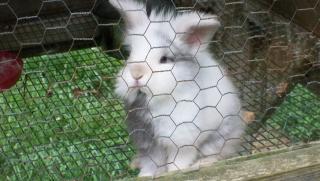I have seen a few misinformed people classify Magpies and Harlequins as two different "types" of rabbits.
As a clarification: Harlequin is a pattern type as well as a breed of rabbit. Magpie and Japanese are the colors the harlequin pattern comes in.
A MAGPIE is a rabbit with the harlequin pattern type in white and any other color (generally dark color).
A JAPANESE (also called a Jap by breeders) is a rabbit with the harlequin pattern type with brown and any other dark color.
This is a Magpie rabbit which is a Harlequin rabbit (the breed):

This is a JAP Harlequin rabbit:

As a clarification: Harlequin is a pattern type as well as a breed of rabbit. Magpie and Japanese are the colors the harlequin pattern comes in.
A MAGPIE is a rabbit with the harlequin pattern type in white and any other color (generally dark color).
A JAPANESE (also called a Jap by breeders) is a rabbit with the harlequin pattern type with brown and any other dark color.
This is a Magpie rabbit which is a Harlequin rabbit (the breed):

This is a JAP Harlequin rabbit:








